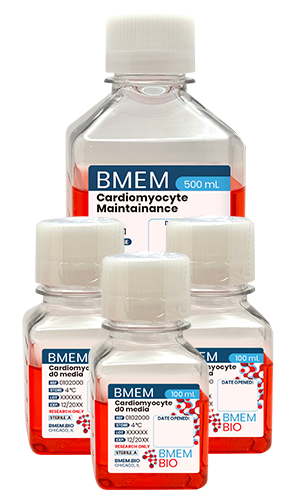BMEM Protein-Free Cardiomyocyte Differentiation Kit
BMEM Protein-Free Cardiomyocyte Differentiation Kit
Optimized cardiomyocyte differentiation for human iPSC
Catalog #1003
Shipping and taxes calculated at checkout
Couldn't load pickup availability
BMEM Protein-Free Cardiomyocyte Differentiation Kit is a ready-to-use highly optimized, chemically defined, animal origin-free (AOF) kit for the differentiation of human induced pluripotent stem cells (hiPSC) to contracting cardiomyocytes (hiPSC-CM) in adherent culture.
This kit is a novel formulation optimized without any proteins. Differentiation using this kit typically produces contracting cardiomyocytes in 8-9 days and results in ~85-90% TNNT2+ cells and yields of >1x105 cells per cm2. Cardiomyocytes can be maintained in BMEM Cardiomyocyte Maintenance Medium for >45 days.
BMEM Protein-Free Cardiomyocyte Differentiation Kit is compatible with hiPSC growth medium BMEM Human Primed Pluripotent(1001).
BMEM Protein-Free Cardiomyocyte Differentiation Kit is compatible with a variety of culture matrices including: Corning® Matrigel® GFR, Gibco™ Geltrex™ GFR, R&D Systems™ Cultrex™ UltiMatrix GFR, Gibco™ Recombinant Vitronectin, and Corning® Synthemax II-SC.
Each lot of BMEM Protein-Free Cardiomyocyte Differentiation Kit is performance tested on hiPSC and sterility tested.
Larger unit sizes are available on request.

| Component Name | Size | Storage |
|---|---|---|
| BMEM Cardiomyocyte d0 | 100 mL | Store at 4°C |
| BMEM Cardiomyocyte d1 | 100 mL | Store at 4°C |
| BMEM Cardiomyocyte d2 | 100 mL | Store at 4°C |
| BMEM Cardiomyocyte Maintenance | 2 x 500 mL | Store at 4°C |

